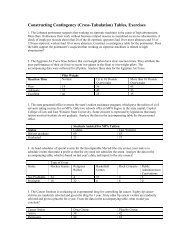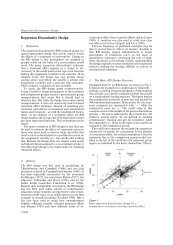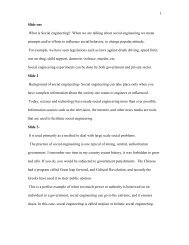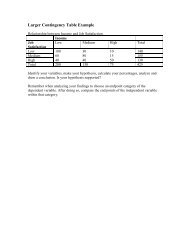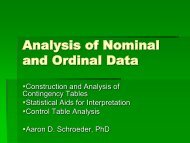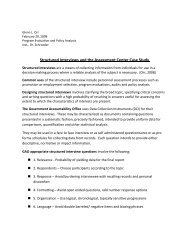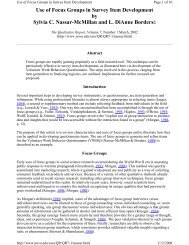The CIPP approach to evaluation
The CIPP approach to evaluation
The CIPP approach to evaluation
Create successful ePaper yourself
Turn your PDF publications into a flip-book with our unique Google optimized e-Paper software.
Figure 1. Five <strong>approach</strong>es <strong>to</strong> <strong>evaluation</strong><br />
Approach Emphasis Focusing issues Evalua<strong>to</strong>r’s role Specific information<br />
needs<br />
1. Experimental Research<br />
design<br />
2. Goal oriented Goals and<br />
objectives<br />
3. Decisionfocused<br />
[<strong>CIPP</strong>]<br />
Decision<br />
making<br />
4. User-oriented Information<br />
users or clients<br />
5. Responsive Personal<br />
understanding<br />
What effects<br />
result from<br />
programme<br />
activities and<br />
can they be<br />
generalized?<br />
What are the<br />
programme’s<br />
goals and<br />
objectives, and<br />
how can they be<br />
measured?<br />
Which decisions<br />
need <strong>to</strong> be<br />
made and what<br />
information will<br />
be relevant?<br />
Who are the<br />
intended<br />
information<br />
users and what<br />
information will<br />
be most useful?<br />
Which people<br />
have a stake in<br />
the programme<br />
and what are<br />
their points of<br />
view?<br />
Expert/ scientist<br />
Measurement<br />
specialist<br />
Decision<br />
support person,<br />
provider of<br />
information.<br />
Collabora<strong>to</strong>r<br />
Counsellor/<br />
facilita<strong>to</strong>r/<br />
collabora<strong>to</strong>r<br />
Outcome measures.<br />
Learner characteristics.<br />
Variation in treatment.<br />
Other influences on<br />
learners.<br />
Availability of a control<br />
group.<br />
Specific programme<br />
objectives.<br />
Criterion-referenced<br />
outcome measures.<br />
Stage of programme<br />
development.<br />
Cycle of decisionmaking.<br />
Data gathering and<br />
reporting.<br />
Personal and<br />
organizational<br />
dynamics.<br />
Group information<br />
needs.<br />
Programme his<strong>to</strong>ry.<br />
Intended uses of<br />
information.<br />
Variation in individual<br />
and group perspectives.<br />
Stakeholder concerns<br />
and participation in<br />
determining and framing<br />
the data.<br />
Programme his<strong>to</strong>ry.<br />
Variation in measures<br />
and sites.<br />
Strengths and limitations of <strong>CIPP</strong><br />
One of the problems with <strong>evaluation</strong> in general is getting its findings used. Through its focus on<br />
decision-making, <strong>CIPP</strong> aims <strong>to</strong> ensure that its findings are used by the decision-makers in a<br />
project. <strong>CIPP</strong> also takes a holistic <strong>approach</strong> <strong>to</strong> <strong>evaluation</strong>, aiming <strong>to</strong> paint a broad picture of<br />
understanding of a project and its context and the processes at work. It has the potential <strong>to</strong> act in a<br />
formative, as well as summative way, helping <strong>to</strong> shape improvements while the project is in<br />
process, as well as providing a summative or final <strong>evaluation</strong> overall. <strong>The</strong> formative aspect of it<br />
should also, in theory, be able <strong>to</strong> provide a well-established archive of data for a final or summative<br />
<strong>evaluation</strong>. <strong>The</strong> framework is flexible enough <strong>to</strong> allow us <strong>to</strong> examine different cases or situations<br />
within the whole project.<br />
Critics of <strong>CIPP</strong> have said that it holds an idealised notion of what the process should be rather than<br />
its actuality and is <strong>to</strong>o <strong>to</strong>p-down or managerial in <strong>approach</strong>, depending on an ideal of rational<br />
management rather than recognising its messy reality. In practice, the informative relationship<br />
between <strong>evaluation</strong> and decision-making has proved difficult <strong>to</strong> achieve and perhaps does not take<br />
in<strong>to</strong> account sufficiently the politics of decision-making within and between organisations.<br />
As a way of overcoming the <strong>to</strong>p-down <strong>approach</strong>es <strong>to</strong> <strong>evaluation</strong>, those of stakeholder and<br />
participative <strong>approach</strong>es have developed (for example, the <strong>approach</strong>es of Richard Stake and<br />
B. Robinson/COLLIT/ 4 May 2002 3





